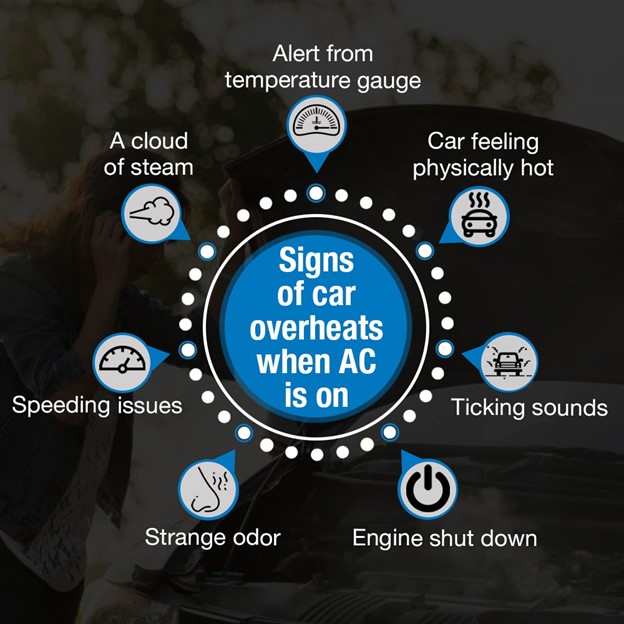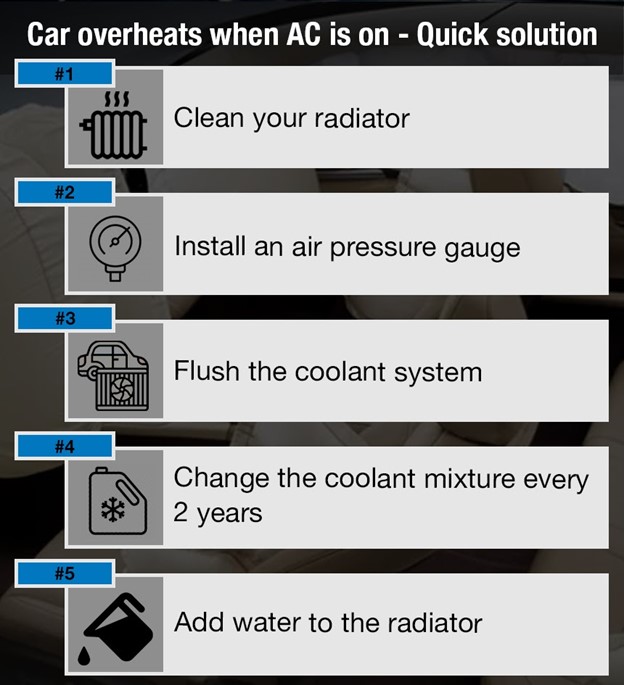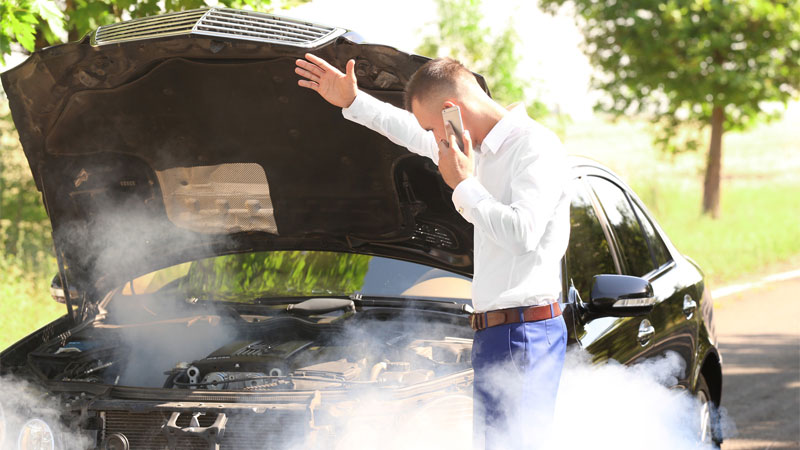There’s nothing wrong with driving your car in the summer as long as you’re comfy in it with the air conditioning on. However, one problem that may occur is the overheating of the vehicle while the AC is on.
First of all, it’s not normal for your vehicle to overheat at any point, whether the AC is on or not. So don’t simply continue driving hoping the problem goes away on its own.
But what does it mean when your car only overheats when the AC is running? Let’s look at five of the most common causes and what you need to do to fix the issue.
Common Symptoms When a Car Is Overheating

1. Needle Keeps Rising on Temperature Gauge
Your car may be equipped with either a coolant temperature gauge or a warning temperature lamp. Monitor the former so it doesn’t go beyond 110 c. If so, then your car is overheating.
Both components will come on as a warning signal if there’s an unusual increase in engine coolant temperature. Check for coolant leaks regularly to ensure that either of the two components works as intended.
2. Car Interior Feeling Physically Hot
If your car is abnormally hot and you can smell rubber or plastic burning, it could mean that it has overheated. The smell could be a sign of plastics and gasket melting.
3. Ticking Sounds From the Engine Compartment
If engine oil is utilized beyond the recommended period, it will stop being viscous. This will mean that it can no longer perform its function in the engine. Friction will start taking place due to the lumps that will be formed after such an occurrence. That could be the reason for the ticking sounds.
See Also – 5 Causes of Engine Ticking Noise
4. Engine Shuts Down
This automatically happens as a precautionary measure in cars overheated—whether the AC is on or not. The car will only start when the temperature has gone down.
5. Strange Odor
Your car’s engine is mainly metallic, but it has additional rubber seals and plastic components. Therefore, an overheated engine usually has a strange, ‘hot’ smell.
Furthermore, if you experience an unusual sweet smell, check if you have a leaking coolant situation. Look for coolant puddles on the ground after parking to be safe from leakages.
6. Poor Acceleration
In most cases, an engine problem like overheating will cause acceleration issues. Your car may also feel sluggish and fail to maintain the speed limit you prefer. Expanded pistons are mainly responsible for this predicament.
7. Steam Coming From Under the Hood
Steam emanating from under the hood is one of the most obvious signs of overheating. It may appear like smoke in some situations, but it is vapored. More often than not, steam results from evaporating coolant due to leakage.
Five Reasons a Car Overheats When the AC Is On
Now that you’ve noticed the problem of overheating, what could be the cause? Well, we’re about to explain the possibilities.

1. AC Compressor Overload
It’s a fact that the compressor puts more load on the engine whenever the AC is on. Conduct a test by putting the AC on and observing the little boost in RPM (rotations/revolutions per minute).
Automobile makers try to ensure that car cooling systems won’t trigger any problems. However, issues start to come up when the compressor seizes, and the accessory belt stops it from turning. The vehicle will keep trying to turn the compressor leading to the overheating of the engine as a result of added pressure.
2. Problem With Radiator
There can be blockages or interferences in the internal pipes of the radiator, which can negatively affect the flow of coolant and air in it, thereby causing overheating. It can be an accumulation of substances such as rust, dirt, and so on. Leakages may also be a factor.
3. Faulty Fan
Your car can overheat when the AC is on, and you’re stuck in traffic or driving slowly. The problem is triggered when the cooling fan (including the cooling motor, fan clutch, or any other component that makes the cooling fan work) has a defect.
For example, the fan moves at diverse speeds depending on the load needed to cool the engine (your car may have two fans). The motor won’t receive adequate cooling if the fan isn’t performing as powerfully as it should—leading to overheating.
Another instance is when there are blockages or interferences in the radiator. Such a situation can lead to the restricted passage of coolant through to the vehicle’s engine, damaging the fan switch.
Apart from the above scenarios, a faulty fan relay can also be a possible factor. It’s obvious that there’s a need to perform maintenance checks on the cooling fan regularly.
4. Other Cooling System Issue
Proceed to examine the other parts of the cooling system after you’ve checked the cooling fan and found nothing wrong with it…
The condenser converts cooling gas from its gaseous form to a liquefied state. It performs this primary role well as long as blockages don’t restrict the flow in the radiator. We discussed the radiator earlier. You can see how it’s an important part of the system in the prevention of overheating.
Back to the condenser—it heats up when the AC is working. This is why there’s a need for a cooling system to keep the condenser’s temperature at an optimal level. The cooling system needs to be performing as well as it should at all times.
Overheating can also be caused by a faulty water pump when the AC is on. A malfunctioning water pump will give rise to inadequate heat depletion.
Read Also – 5 Symptoms of a Faulty Thermostat
5. Defective Engine Coolant Sensor
The engine coolant sensor signals the control module to switch the cooling fans on, so this device may be the cause
of your overheated car. Why? It may not be signaling the control module correctly.
In case, after diagnosis, you still cannot find out the causes of this situation and things get even more complicated, you should scan for trouble codes related to your AC system using a quality diagnostic scan tool. Hopefully, it will help you discover the root of the issue.
How to Fix the Problem
Implement the tips below depending on your discovery.

1. Clean Your Radiator
Clean the radiator to get rid of blockages and interferences that will limit airflow and coolant passage. It should also be inspected for leakages with the aid of a radiator testing kit. Clamps and hoses should be substituted with new ones if needed.
2. Install an Air Pressure Gauge
The installation of an air pressure gauge is necessary to monitor the flow of air. It can be fixed at any of the radiator ends.
3. Flush the Coolant System
You should find out if this is what your car needs when it has overheated. Do this to make way for a new coolant mixture. You’d also be trying to get rid of corrosive substances, salts, dirt, rust, and so on.
Tip: Check the coolant system of your car regularly. Doing this will help you discover issues at their early stages before they become critical.
4. Change the Coolant
As a general rule, your coolant should be replaced about every 30,000 miles (check your owner’s manual for the exact timeframe for your model). Make sure that you do so with a coolant compatible with your vehicle’s engine and in the right concentration.
You should steer clear of tap water (use distilled water) because of the corrosive substances and salts that it may have. Doing these will prevent corrosion and rust in the radiator, water pump, and internal parts of the engine.
5. Keep Coolant Overflow Tank Topped Up
The radiator should never be dry, so make sure you have a proper amount of coolant and water in the system. Always use distilled water instead of regular (tap) water when diluting the coolant to prevent unwanted substances like dirt from getting into the system.
Important: Always let a car engine completely cool down before checking or servicing your cooling system or severe burns or other injuries may occur from the pressurized, extremely hot coolant.
What to Do If a Car Overheats With the AC On in Traffic?
This could be a real bummer. Aaargh! Still, try to keep calm and follow the steps below.
Step 1: Pull Over as Soon as Possible
This is the very first step that you should take. Ensure that the conditions are right before doing so. Remember, safety first.
Step 2: Turn Off the Air Conditioner
This should be done immediately, especially when you realize that there’s no chance to pull over. Confirm that it’s safe to set the vehicle in park or neutral when you have to wait for a stoplight. It’s a way to reduce the temperature of the engine a little.
Step 3: Open the Hood of Your Car
As stated earlier, safety first. Be sure that it’s OK to do this because of the temperature of the hood. Therefore, play safe by checking to see if steam is escaping from under it. If so, be patient for a while. Opening the hood will greatly reduce the temperature of the engine.
Step 4: Turn Off the Car Engine But Keep the Key in the ON Position
Set the vehicle on park and put off the engine if you’re able to pull over successfully. The fan will continue running (in some car models) as long as you leave the key in the ON position. Substitute the fan with a new one if you discover that it isn’t on. This could also mean that it’s linked to the overheating problem.
See Also – 5 Causes of a Key Stuck in the Ignition
Step 5: Check for Leaks
Once the engine has cooled down, proceed to check for leaks and/or call an expert for help. Patch up any leaks you find with radiator hose tape or by tightening a clamp. Fill up the radiator with coolant and water after. The expert you called should do a complete check to discover everything that went wrong with the engine.
Charts supplied by Tim Miller. All rights reserved.
- History of the Chevrolet SSR: The Retro-Styled Convertible Pickup - Apr 25, 2024
- The History of the BMW M Coupe (the “Clown Shoe”) - Mar 26, 2024
- The History of the Ford Flex - Feb 28, 2024

